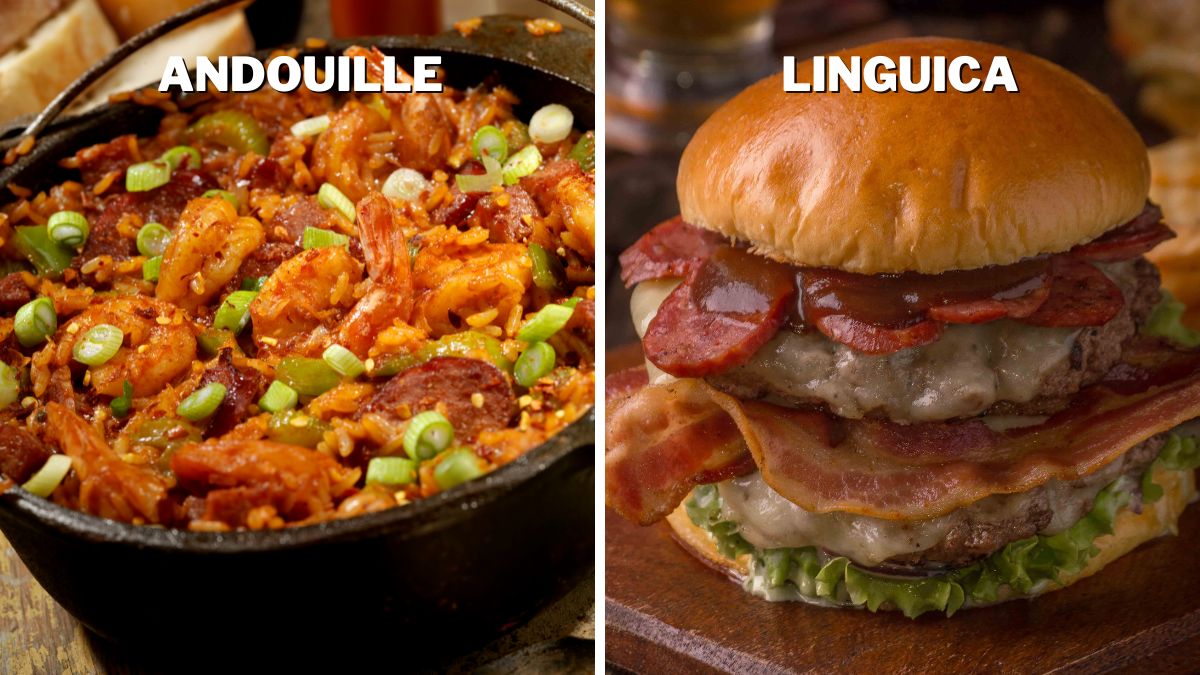Andouille vs. Linguica: Differences & Uses

Andouille and linguica are both sausages that can make my mouth water just by looking at them, but they are quite different with their respective sets of fans. As you’ve probably guessed, I am a fan of both, but you might prefer one or the other if you know the differences between them. So what are the differences and similarities between аndouille and linguica?
Andouille and linguica are both cured sausages made with pork and spices but have different origins, spice blends, textures, and smoke flavors. Andouille is associated with Cajun cuisine and is coarser and smokier, while linguica is a Portuguese sausage with a milder flavor profile and smoother texture.
Since these cured delicacies often feature in my cooking, I have gathered some wisdom that I would like to share. So, in this article, I’ll tell you all about these two sausages, so you can enjoy them even more than I do.
Ingredients
Being that they are both made with pork, andouille and linguica share some similarities in terms of ingredients. The base ingredient is the same, and they both contain spices.
Even though both sausages are typically made with pork as the primary meat ingredient, there are also beef or other meat varieties. Still, the pork versions are my favorite, and I think they are objectively more delicious.
Both use garlic and spices for flavoring. Still, the spice blend used in andouille tends to be under greater influence by the flavors of the Cajun region, with a focus on spicy and savory flavors. Linguica has a milder flavor profile focusing on paprika and other spices commonly used in Portuguese cuisine.
In summation, the recipe for both can vary depending on the region and the maker’s preferences. Generally, andouille includes ingredients such as pork shoulder, garlic, onion, salt, black and cayenne pepper, thyme, and paprika. Linguica may include pork butt, garlic, salt, paprika, and vinegar, among other ingredients.
Appearance & Taste
Both sausages have the typical sausage link appearance, but you can easily recognize which is which, as they have their own distinct looks.
Andouille has a coarse texture and is often brown or reddish-brown in color. It is very appealing and inviting, especially due to its pungent aroma. I cannot resist an andouille sausage because I just love those little meat pieces inside the casing.
On the other hand, linguica is a more subtle type of sausage. It is smoother and more compact than andouille, with a more uniform texture, and it usually has a deep red color. Just like andouille, it is very appetizing to look at.
In terms of taste, I would say that I love them both, but they do taste differently. Andouille has a robust and smoky flavor and is often spicy, which is to be expected since it contains a stronger spice blend.
Linguica is the mellower of the two but still very flavorful. It is slightly sweet and tangy, with a hint of smokiness. Still, that hint of smokiness makes a huge difference since it gives the sausage a seductive flavor, enhancing the rest of the notes.
It is often used in dishes like feijoada (a Brazilian bean stew) and as a topping for pizza.
Cooking Method & Serving Style

Although similar-looking and coming from the same base ingredient, these types of sausages are pretty different when it comes to cooking methods. Their differences in texture are the main predetermines of their cooking styles which is why you can’t cook both in the same way.
Not that they would be bad-tasting if you cooked them wrong, but they won’t shine through ultimately, which would be a shame.
Andouille is commonly associated with Cajun and Creole cuisines, particularly in the southern United States. This means that it is stronger in flavor, more pungent than linguica, and better suited for spicier and edgier dishes.
Andouille sausage is often used in dishes such as gumbo, jambalaya, red beans, and rice. You can add it to stews and soups or cook it on its own by grilling, pan-frying, or simmering. My favorite way to cook andouille is to grill it and make a mean sausage sandwich.
Linguica is the perfect example of Portuguese cuisine’s traditional flavor. It’s an important part of Portuguese cuisine, which isn’t traditionally spicy but very flavorful. It is very vibrant and lively but not overbearing or overly spicy. Using it in spicy dishes isn’t a good idea because the flavor of the sausage would be lost.
Of course, you would still enjoy it, but only partially. You can grill, pan-fry, or bake it, just like andouille, but you shouldn’t combine it the same way. Linguica works best when incorporated into dishes like stews and soups, in sandwiches, or as a pizza topping.
Neither linguica nor andouille has a particular serving style, as they are more of an ingredient than a dish in themselves. Also, they are wholesome, rustic people’s meats meant to have in many ways. So, whatever you decide on goes.
You can have them in breakfast dishes such as omelets or on the side. You can make delicious lunch meals, snacks, or dinners with both. They work great with other ingredients such as cheeses, eggs, veggies, or salads and go excellent with soups and stews.
I just follow the simple rule of thumb: combining andouille with spicier foods and linguica with mellower-tasting meals.
Substitutes
When it comes to substituting linguica and andouille, the most common question is whether or not you can substitute one for the other. Yes, you can substitute linguica for andouille and vice versa, but set different expectations.
These two sausages have clearly defined uses, and you cannot expect your dish to taste the same if you use one instead of the other. Still, considering that they are both made with pork and that they are smoked, they share some of their features, making them suitable substitutes for each other.
I use linguica instead andouille more often than the other way around because I can always add more spices to achieve the andouille flavor. Still, you can mix and match any way you like.
Smoked sausage, such as Polish sausage kielbasa, is a good substitute for both andouille and linguica. Even though the flavors may not be the same, they can provide a similar smoky taste to your dish.
Chorizo is another good substitute for both. It is spicy enough, so it can work well as a substitute for andouille. Still, it is also compact and gentle, making it a good linguica substitute as well.
